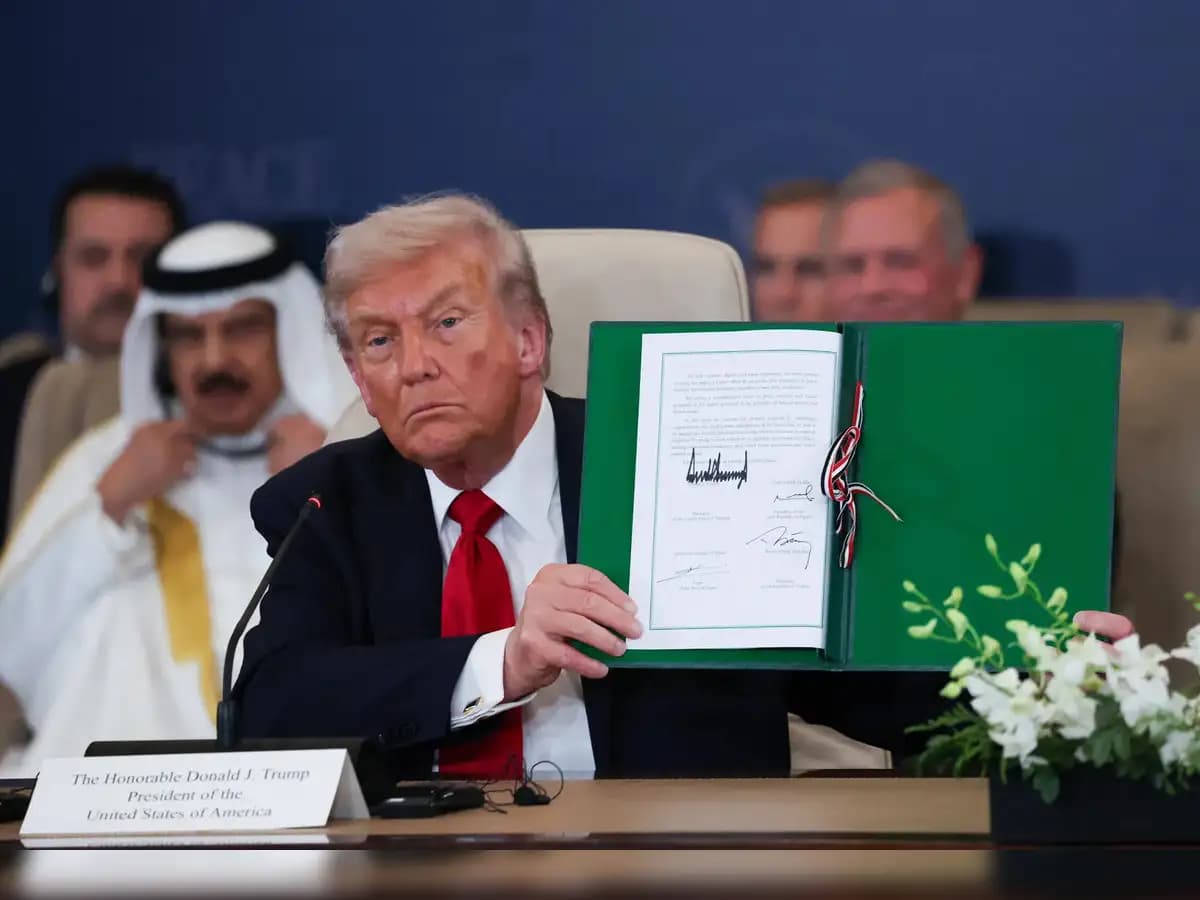Loading News Article...
We're loading the full news article for you. This includes the article content, images, author information, and related articles.
We're loading the full news article for you. This includes the article content, images, author information, and related articles.
A new declaration for peace in Gaza, signed by key international players, signals the end of a protracted conflict and initiates a massive rebuilding effort. This development holds significant implications for regional stability and humanitarian aid, with Kenya welcoming the breakthrough.

US President Donald Trump, alongside leaders from Egypt, Qatar, and Turkey, formally signed a declaration for peace in Gaza at a summit held in the Egyptian resort of Sharm el-Sheikh on Monday, October 13, 2025. The agreement, referred to as the 'Trump Declaration for Enduring Peace and Prosperity,' aims to cement a ceasefire between Israel and Hamas, ending more than two years of conflict.
President Trump, addressing the Israeli parliament (Knesset) earlier on Monday, declared that "the long and painful nightmare is finally over," expressing optimism for a new era. He reiterated this sentiment at the Sharm el-Sheikh summit, stating, "A new and beautiful day is rising and now the rebuilding begins."
The peace declaration follows a period of intense negotiations and a broader 20-point plan announced by President Trump in late September 2025. This plan set a deadline for Hamas to accept the proposal by October 5, 2025. On October 3, 2025, Hamas agreed to release remaining hostages in Gaza and hand over administration of the Gaza Strip to a Palestinian body of independent technocrats, though it did not agree to disarm.
The first phase of the peace plan, which included a ceasefire and hostage release deal, was signed by Israel and Hamas on October 9, 2025. As part of this, Hamas released all 20 remaining living Israeli hostages, and Israel released nearly 2,000 Palestinian prisoners and detainees on Monday, October 13, 2025.
The 'Trump Declaration for Enduring Peace and Prosperity' outlines a commitment to resolving future disputes through diplomatic engagement and negotiation rather than force. It emphasizes mutual respect, shared destiny, and the protection of fundamental human rights for both Palestinians and Israelis. The plan also stipulates that regional and international partners will work to develop a new Palestinian security force. Reconstruction efforts are expected to be Palestinian-led, with no role for Hamas in future governance.
The agreement has garnered support from numerous countries globally, including France, Germany, Russia, Italy, Spain, the United Arab Emirates, Jordan, Indonesia, Pakistan, Canada, and the United Kingdom. Egyptian President Abdel Fattah el-Sissi lauded President Trump for sealing the ceasefire, stating it "closes a painful chapter in human history and opens a new era of peace and stability" for the region.
Kenya has welcomed the first phase of the ceasefire agreement, describing it as a vital step towards easing human suffering in Gaza. Prime Cabinet Secretary and Cabinet Secretary for Foreign and Diaspora Affairs Musalia Mudavadi, in a statement on Thursday, October 9, 2025, expressed Kenya's condolences to families who lost loved ones and reaffirmed the country's solidarity with the victims. He noted that the accord aligns with Kenya's long-standing position, articulated by President William Ruto during the 80th Session of the United Nations General Assembly in September 2024, which champions global peace and a lasting solution anchored on the two-state solution.
While the agreement marks a significant breakthrough, the situation remains fragile, with major questions regarding Gaza's postwar governance, Israel's demand for Hamas to disarm (which the group has rejected), and Palestinian demands for a state (which the current Israeli government has rejected). Negotiations on these thornier issues could break down, and Israel has hinted at resuming military operations if its demands are not met.
Details on the specific timelines, costs, and safeguards for the rebuilding process remain largely unclarified. Analysts emphasize that many details still need to be "hammered out," including whether Hamas will agree to disarm. The summit in Sharm el-Sheikh did not include representatives from Israel or Hamas.
The signing of the peace declaration on Monday, October 13, 2025, marks the official commencement of rebuilding efforts. President Trump indicated that phase two of his Gaza plan, concerning reconstruction, is already underway. Egypt plans to host a future reconstruction conference. The UK will also host a three-day conference to coordinate plans for Gaza's recovery and reconstruction.
Observers will be closely watching the implementation of the ceasefire, the flow of humanitarian aid, and the progress of negotiations on the more complex issues of governance and disarmament. The commitment of international partners to funding and supporting Gaza's reconstruction will also be crucial for long-term stability.
Keep the conversation in one place—threads here stay linked to the story and in the forums.
Other hot threads
E-sports and Gaming Community in Kenya
Active 6 months ago
Popular Recreational Activities Across Counties
Active 6 months ago
The Role of Technology in Modern Agriculture (AgriTech)
Active 6 months ago
Investing in Youth Sports Development Programs
Active 6 months ago